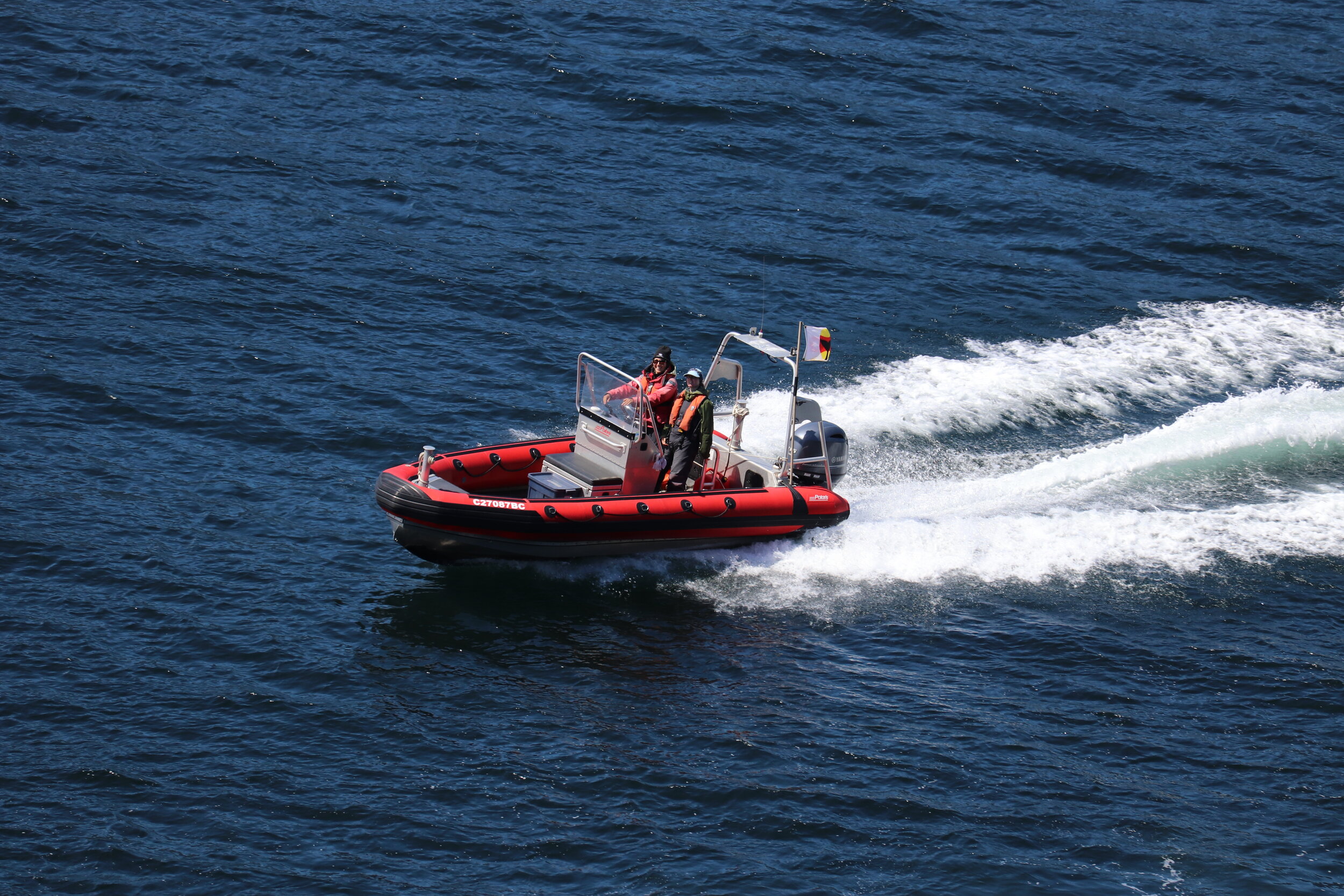
Be Whale Wise
Regulations & Guidelines
Canadian Regulations:
Must maintain a minimum 400m distance from all Killer Whales in SRKW critical habitat
Must maintain a minimum 200m distance from all Killer Whales outside critical habitat
Must maintain a minimum 100m distance from all marine mammals, 200m if they are resting or with a calf.
Must not position a vessel in the path of Killer Whales
US Regulations:
Must maintain a minimum of 300 yards away on either side and 400 yards in from or behind SRKW
Must maintain a minimum 200 yards away on either side and 400 yards in from or behind Transients
Must slow to 7 knots within ½ mile of any Killer Whale and disengage engine within 300m of any Killer Whale
Must maintain a minimum of 100 yards from all marine mammals
The Guidelines:
Whale Warning Flag (Top) & Purple AV Flag (Bottom)
Whale Warning flags are used to let other mariners know that whales are in the area and to slow down. You can get one here.
The AV flag is flown by vessels that have an exemption to the 400 m distance regulation from Transient Killer Whales and may view from 200 m.
Turn off fish finders and echo sounders when not in use.
Use the Whale Warning Flag to warn fellow boaters to the presence of whales and be aware of the flag when you are cruising the area.
Go slow (<7knots) within 1,000 metres, or a half mile, of killer whales.
Refrain from fishing, where possible, within 1,000 metres or half mile of killer whales.
Groups of kayakers should raft up in the presence of whales and remove paddles from water.
Stay on the offshore side of the whales when they are traveling close to shore.
Limit your viewing time to a recommended maximum of 30 minutes. This will minimize the cumulative impact of many vessels and give consideration to other viewers.
Do not drive through groups of porpoises or dolphins to encourage bow or stern-riding.
Being "whale wise" is one of the most important ways boaters, kayakers, and other mariners can help BC's vulnerable whales. By following the regulations and Be Whale Wise guidelines, mariners can profoundly diminish the negative impact their presence on the water has on whales and other marine mammals. The guidelines advise sound and sensible etiquette and responsible behaviour for boaters while on the water, particularly when in the vicinity of whales and other marine mammals. The guidelines always advocate the minimum distance—400 metres for killer whales and 100m for other Cetaceans —to be kept from whales and other animals. This distance must be observed regardless of size/type of vessel or activity engaged in. If you are unsure of the distance, always err on the side of caution and move further away.
The Be Whale Wise guidelines are straightforward and easy to follow. Always use extreme caution when there are (or are suspected to be) marine mammals in the area. Be attentive and aware of all that is happening, in all directions, when on the water. Always remain a minimum of 400 metres from any Killer whales, and 100m away from all other marine mammals in Canadian waters. Keep speeds to a maximum of 7 knots if within 400 metres of a whale and carefully alter course to get out of their way. It is particularly important to stay out of the path of whales. If a whale (or whales) is approaching you, carefully move out of the way, if it is safe to do so if it is not the best thing you can do is shut off you engine and wait for them to pass. Remaining in the path of whales is extremely disruptive for them, causing an unnecessary obstacle they must expend valuable energy to avoid. In addition, whales on the move may be in what is called a "rest line," getting critical rest, that a vessel in their way will interrupt. Do not, ever, attempt to feed, touch, or swim with or near whales.
The Be Whale Wise guidelines were developed by Cetus's predecessor organization, M3, in 2001 in collaboration with other stakeholders. The guidelines were a direct response to the increasing intensity of whale-watching and recreational boating in the whales' habitat. Since 2001, these activities have increased enormously. The primary distribution method for the guidelines was, as it is now, via brochures distributed on the water and at docks to boaters. The guidelines are always being reviewed and amended, informed by ongoing research and data collection. For example, the guidelines have recently been amended to include issues raised by, and with advice for, kayakers. The increasing presence and impact of drones is currently being assessed. The Be Whale Wise guidelines are a critical component in the attempts by government and organizations like Cetus to protect whales and minimize the harm done by human activities.
Ultimately, it is best, if watching whales, to view them from shore. (There are many locations on Vancouver Island and the Gulf Islands that offer extraordinary viewing sites from which to safely enjoy the sight of these incredible animals.) If, however, you do find yourself on the water and in the vicinity of whales, always err on the side of extreme caution and keep a far distance from them, for their sake and your own. Always, when on the water and in the wild, behave with courtesy towards the whales.
If you see a mariner, or other person disturbing or harassing a marine mammal, call 1-800-465-4336 as soon as possible. If able, note any identifying information regarding the mariner.



